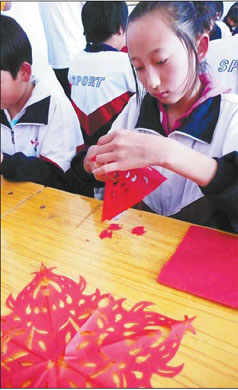Life and Leisure
Where diplomacy is the art of paper-cuts
By Lan Tian (China Daily)
Updated: 2010-09-03 08:13
 |
Large Medium Small |
You would be forgiven for mistaking an image of US President Barack Obama in Guangling for a photograph.
Although a paper-cut, its multiple layers in different colors produce not just a striking resemblance to its subject but also captures the subtleties of his facial expressions.
No wonder it was presented as a national gift to Obama in 2009 by Xu Caihou, vice-chairman of China's Central Military Commission.
Craftsmen toiled for two months to complete the nine-layer paper-cut, whose replica is now on exhibition at the China Pavilion at the Shanghai Expo, says Wang Zengrong, chairman of Huihua Company in Guangling county of Shanxi province, the birthplace of this folk art.
|
The young are picking up the old handicraft of Guangling-style paper-cutting. Lan Tian / China Daily |
Paper-cuts by Huihua, which combine traditional techniques with modern images, are much sought after as national gifts by the ministries of foreign affairs and culture.
Paper-cutting is a distinctive Chinese handicraft that goes back thousands of years. Often used during festivals to decorate windows and doors, they are sometimes referred to as "window flowers". They are mostly used to express hope, comfort and good wishes.
A big red paper character xi (happiness) has become de rigueur on a newly-wed's door, while a pattern of plump children cuddling fish conveys wishes for year-long abundance.
Paper-cutting in Guangling first appeared in the Tang Dynasty (AD 618-907) and took on its distinct form during the Ming Dynasty (1368-1644). Derived from traditional embroidery, it is reputed for its exquisite cuts, elaborate colors and vivid details.
But before 2006, this folk craft was on the brink of disappearing, says Zhang Duotang, a fourth-generation member of Guangling paper-cutting's founding family and curator of the Guangling Paper-cutting Art Museum.
Since 2006, the local government has stepped up efforts to protect this folk art, by funding research and training in paper-cutting and promoting exhibitions to create more awareness.
With government support, Zhang opened the country's first paper-cutting school in 2007, offering free board and lodging - and training - for 1,100 students.
"We teach the skill to anyone who wants to learn," he says.
Enlisted as a world intangible cultural heritage by UNESCO in 2009, Guangling paper-cuts have found markets in the US, Canada, Japan and other countries.
Local farmers have also benefited from the budding industry, with more than 3,000 employed in some stage or other of the business.
"I don't want to go to the cities. I want to stay at home and become a paper-cutting artist like my grandfather and father," declares 17-year-old Wang Qingyong, the youngest of an old paper-cutting family of Jiaoshan village.
Thanks to the boom, Wang's family, with more than a dozen members involved in the business, saw an annual income per-capita of more than 10,000 yuan ($1,470) last year, which is three times the local average.
